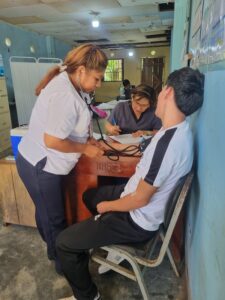
Story by Cmdr. Marshall Hoffman
Naval Medical Research Command
LIMA, Peru – Researchers from U.S. Naval Medical Research Unit (NAMRU) SOUTH have an ongoing collaboration with local Peruvian hospitals to surveil pathogens causing febrile (having to do with fever) and respiratory diseases such as dengue, malaria, influenza and COVID-19 in Peru and other partner nations in Central and South America.
The aim of these studies, funded by the Department of Defense Global Emerging Infections Surveillance (GEIS), is to identify the specific causes of acute respiratory and febrile illnesses found in patients at military and civilian health facilities across the U.S. Southern Command (SOUTHCOM) area of operations (AOR), and better address the healthcare needs of those affected. Such illnesses pose a threat to the readiness of U.S. and partner nation service members in countries across the globe.
On a monthly basis, or sooner if a new circulating pathogen or outbreak is detected, NAMRU SOUTH shares its data with the local Ministry of Health, GEIS and relevant collaborators, including academia and non-governmental organizations.
NAMRU SOUTH performs infectious disease surveillance at military and civilian hospitals throughout Peru in Lima, Cusco, Iquitos, Trujillo and Tumbes, in addition to Honduras, Panama, Guatemala, Colombia and Paraguay. The command collects biological samples from people with acute respiratory or fever symptoms and analyzes them for pathogen identification and detection of genetic markers of antiviral resistance. Since 2010, more than 50,000 samples have been collected and tested.
“We can inform the U.S. and Peruvian militaries about disease-causing pathogens that are currently circulating, and genetic markers that can render the pathogens less sensitive to certain medications,” explained Dr. Yeny Tinoco, principal investigator of NAMRU SOUTH’s Acute Respiratory Infections surveillance study.
Headquartered in Lima, and with surveillance activities across Central and South America, NAMRU SOUTH contributes to the world’s understanding of infectious diseases in Peru and beyond. The command’s activities recently discovered the migration pattern into Northern Peru of Oropouche virus, which is spread by mosquitos and causes a febrile illness. Additionally, NAMRU SOUTH recently completed genome sequencing and molecular analysis of a highly pathogenic (meaning an illness caused by a bacteria or virus) avian influenza A(H5N1) virus provided by the Peruvian Ministry of Agriculture, aiding the first confirmation of a case of highly pathogenic avian influenza virus A(H5N1) in Peru. The results from this analysis were key to helping the National Service of Agrarian Health (SENASA) declare a health alert throughout Peru. NAMRU SOUTH and SENASA continue to collaborate in the monitoring of influenza viruses in animals in Peru.
These activities are part of GEIS biosurveillance efforts to inform decision-making and ensure Force Health Protection by assessing of the presence of animal influenza viruses with pandemic potential circulating in the SOUTHCOM AOR. The studies have detected new viruses and virus variants, identified new geographic locations of existing arboviruses and respiratory viruses and provided early detection of outbreaks.
“Many of the surveillance sites do not have the means to perform laboratory diagnostics and rely only on clinical diagnoses,” said Dr. Julia Sonia Ampuero, principal investigator of NAMRU SOUTH’s Febrile and Vector-Borne Infections surveillance study. “Surveillance data serves as the foundation for determining geographic and temporal risks to military service members in Central and South America, and increases our understanding of the true burden of these diseases.”
GEIS is committed to providing early and accurate detection of emerging infections that may potentially threaten Force Health Protection and global health security by rapidly implementing mitigation efforts to decrease the risks to U.S. service members and the DoD mission through the GEIS laboratory network since 1997.
NAMRU SOUTH, part of the Navy Medicine Research & Development enterprise, conducts research on a wide range of infectious diseases of military and public health significance, and supports Global Health Engagement through surveillance of those diseases, including dengue fever, malaria, diarrheal diseases and antimicrobial-resistant infections.